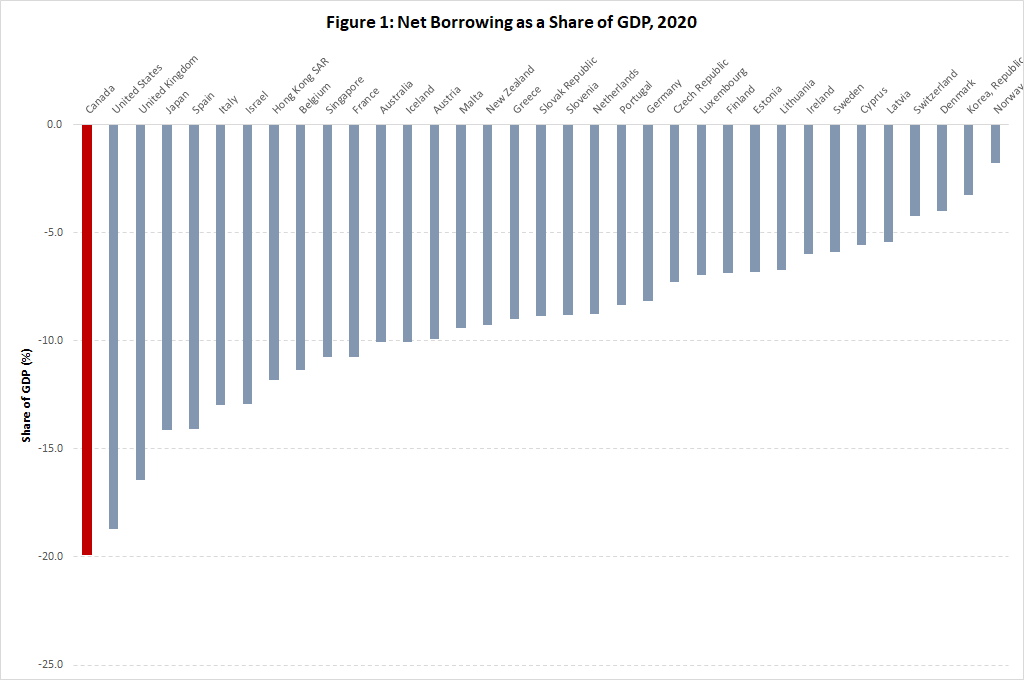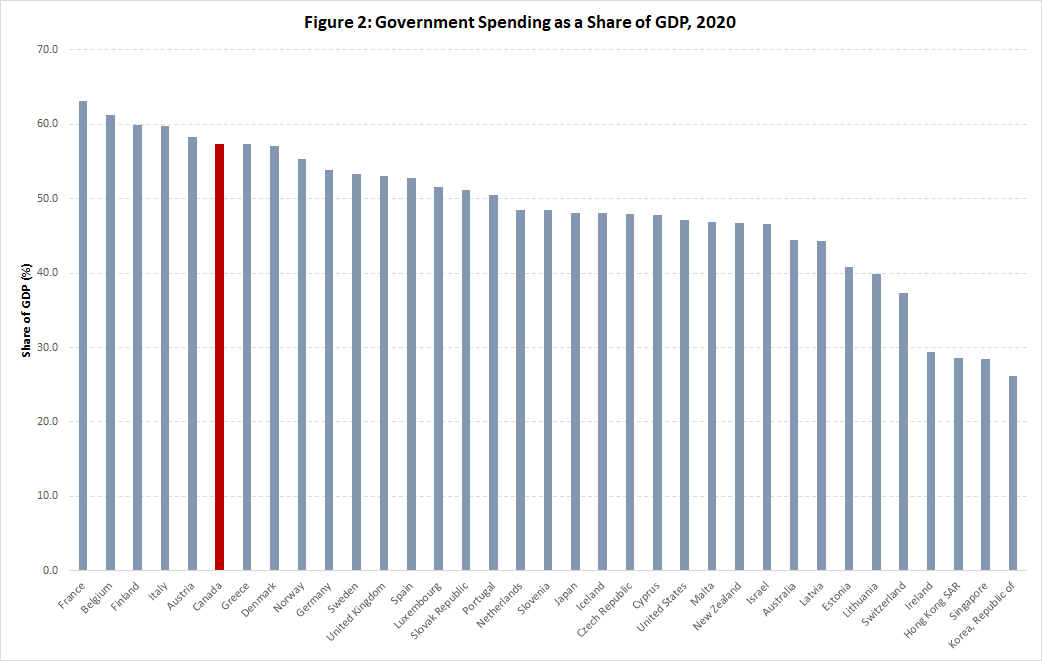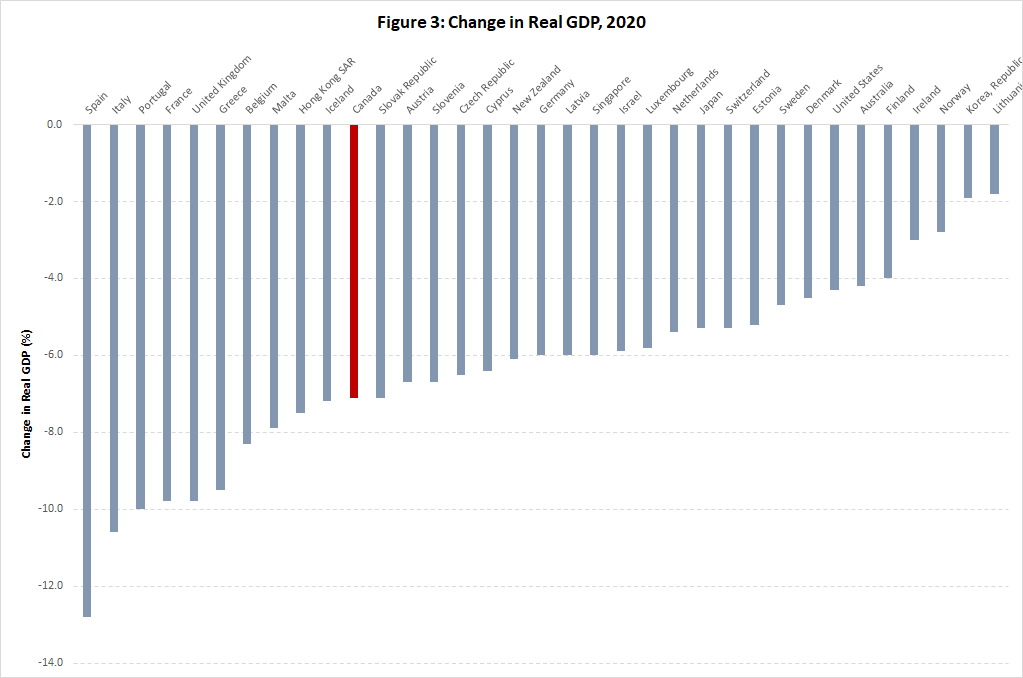Canada’s spending and deficits higher than comparable countries during pandemic

Governments around the world have significantly ramped up spending due to the COVID-19 recession. However, recent data from the International Monetary Fund’s semi-annual fiscal monitor reveals that Canada has largely outpaced other countries in the scale of both spending and deficits.
In its fiscal monitor, the IMF estimates the level of net borrowing (deficits)—across all levels of government—as a share of the economy for 35 high-income countries in 2020. Among this group, Canada has the highest deficit-to-GDP ratio at 19.9 per cent (see first chart below). To put this in perspective, Canada’s net borrowing is more than double the ratio of Germany and triple that of Sweden and Ireland. Furthermore, Canada ranks higher than the United States (18.7 per cent), United Kingdom (16.4 per cent) and is almost double that of Australia (10.1 per cent), which has a similar economy to Canada.

Net borrowing is a result of both lower revenues and higher recession-related spending. As the second chart shows, however, Canada ranks high on all-government spending as a share of the economy.
Specifically, Canada ranks 6th highest of the 35 high-income countries included in the IMF report for the share of the economy represented by government spending (57.3 per cent). Only France, Belgium, Finland, Italy and Austria rank higher than Canada on the expected level of all-government spending in 2020 (again, as a share of their economies). Canada’s 57.3 per cent ranks higher than countries such as Norway, Germany, Australia and the U.S. Indeed, Canada’s ratio is more than 10 percentage points higher than both Australia—the most comparable economy to ours—and the U.S.

The scale of government spending in Canada raises additional concerns for the future given that research on the optimal size of government (relative to economic growth and social progress) demonstrates that the optimal size of government ranges between 24 per cent and 32 per cent of the economy in terms of maximizing rates of economic growth. At nearly 60 per cent of GDP, the size of government in Canada is almost double the optimal level for economic growth, which means concerted efforts are needed to reduce the share of the economy represented by government spending.
Notably, Canada’s relatively high level of government spending has not translated into better economic performance than our peers. Among the 35 advanced economies tracked, Canada is expected to experience the 11th highest contraction in real GDP (7.1 per cent).
In fact, many countries whose governments spent less than Canada in response to the recession, are expected to fare better economically with smaller reductions in output (see final chart below). For example, Australia’s economy is forecast to contract by 4.2 per cent, the U.S. economy by 4.3 per cent and Germany’s by 6.0 per cent. Simply put, Canadian governments are spending and borrowing more than most other industrialized countries—while achieving poorer economic performance.

Moreover, there are concerns that Canadian governments have given little attention to targeting assistance and may be wasting money by focusing on expediency rather than efficiency and effectiveness in spending. For instance, a recent study estimates that Ottawa has spent up to $22.3 billion in poorly targeted assistance during the pandemic.
This includes $503.5 million in Canada Child Benefit (CCB) payments to families with more than $100,000 in income in 2019 and about $12 billion spent on the Canada Emergency Response Benefit (CERB) for nearly one million young people aged 15 to 24 who live at home with their parents in households with incomes of at least $100,000 (2019).
Other potential wasteful spending includes $7.0 billion in CERB for spouses in families with at least $100,000 in income, $1.6 billion on the Canada Emergency Student Benefit (CESB) for students living in families with more than $100,000 in household income, and $1.4 billion in onetime payments to seniors ineligible for the Guaranteed Income Supplement (GIS).
Simply put, Canadian governments have spent considerably more money (mostly borrowed) than comparable countries around the world—with plenty of potential wasteful spending—while at the same time achieving relatively poor economic performance.
Authors:
Subscribe to the Fraser Institute
Get the latest news from the Fraser Institute on the latest research studies, news and events.

